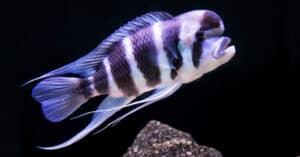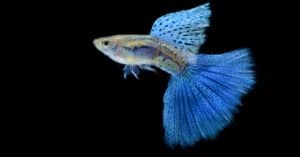- Discus fish are usually happier sharing a tank with other peaceful fish, rather than being alone.
- Tankmates should have similar water requirements as discus fish. Temperatures from 82 to 86 degrees Fahrenheit with a water pH of between 6.0 and 7.0 are best.
Discus fish sport spectacular color combinations and a unique round shape, earning them the name “king of the aquarium.”
A freshwater species of the Cichlidae family, the discus is native to the Amazon River basin in South America. In its natural habitat, the discus will gather in still waters of lakes or flood areas often near fallen trees, decayed wood, and grasses that are very useful for hiding purposes. They shun locations with strong tides or waves, which is likely why they adapt so well to an aquarium environment.
What tankmates go best with these calm, colorful creatures?
#1 Siamese Algae Eater (Crossocheilus oblongus)
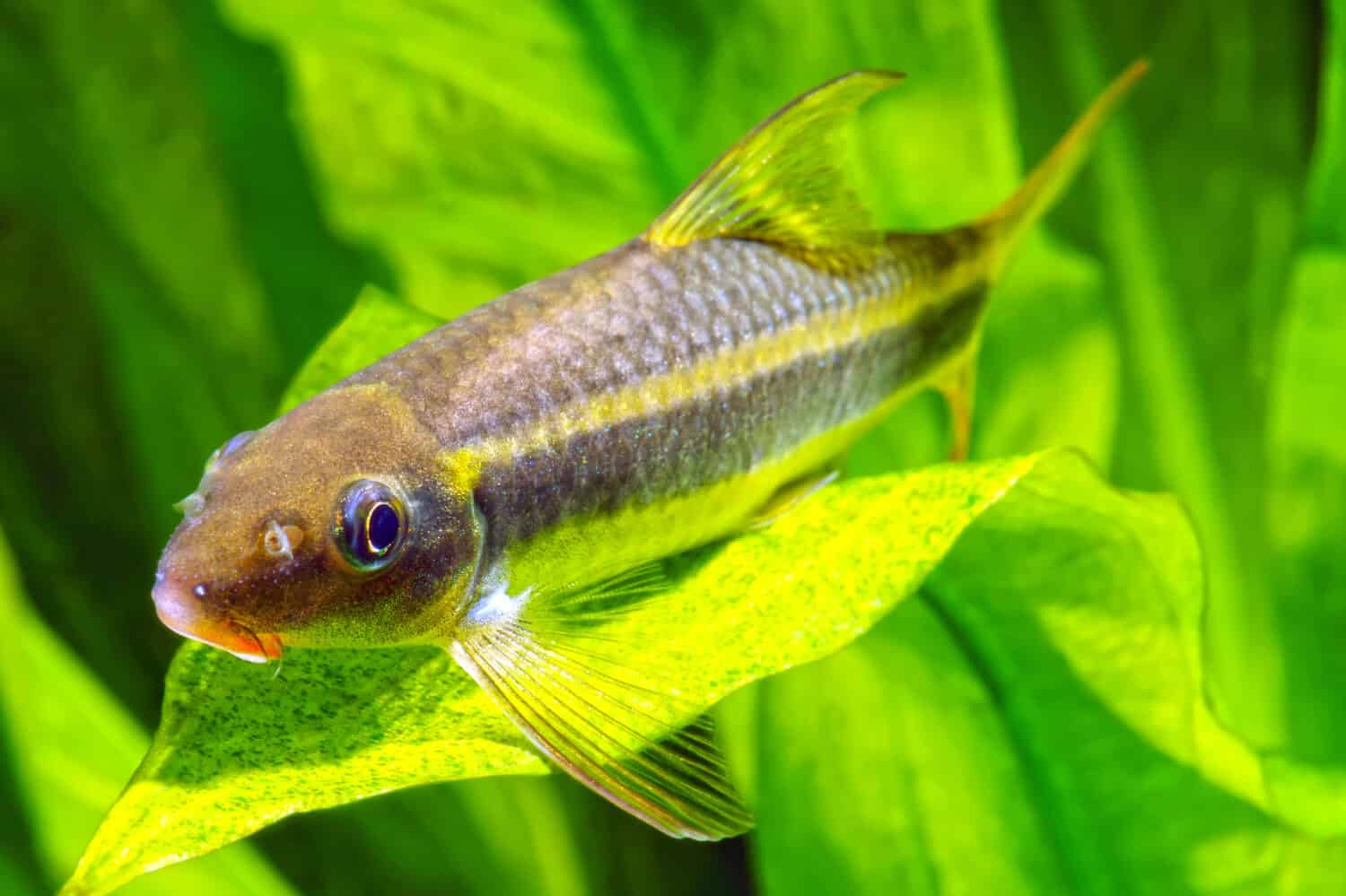
A fresh-water bottom-dweller, the Siamese algae eater is a member of the carp family.
©Grigorev Mikhail/Shutterstock.com
The Siamese algae eater is a peaceful species that cohabits well with the discus. As the name implies, it scavenges for algae, although sometimes the luxury of tank life will cause it to eat food meant for the discus and others instead of doing its job of keeping the tank clean! Siamese algae eaters are easy to care for, and get along well with most tankmates. These fish thrive in the same water temperature range as the discus, but be sure to provide some shade at the bottom of the tank.
#2 White Cloud Minnow (Tanichthys albonubes)
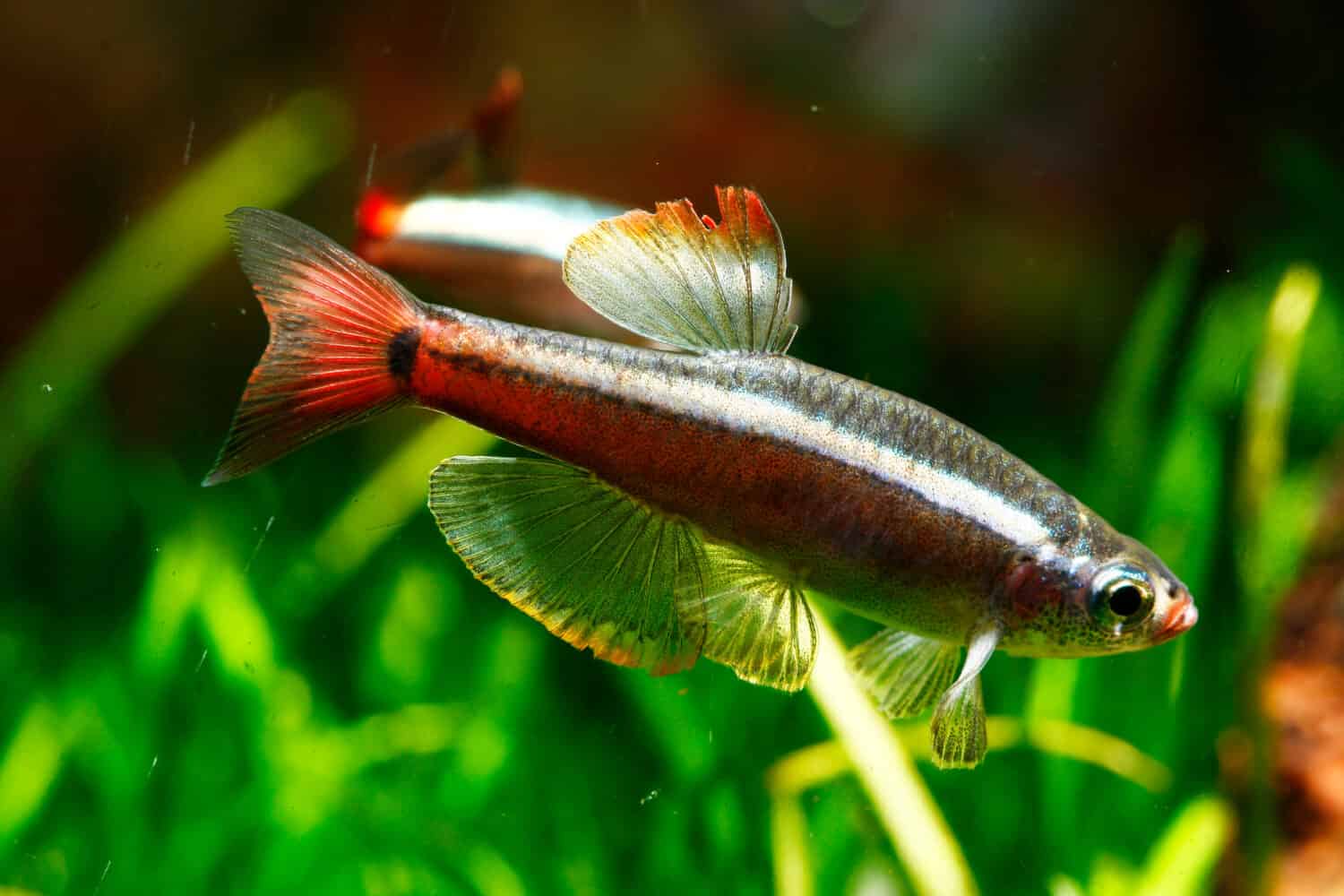
White cloud minnows are originally from China, but due to pollution, there are very few of them left in their native habitat.
©Pavaphon Supanantananont/Shutterstock.com
Another tankmate that’s quite compatible with the discus is the white cloud minnow. Calm and peaceful in temperament, these fish are particularly beautiful in small schools of at least eight. If kept alone, they often become timid and can lose their lovely colors. They tend to group in the middle and upper areas of the tank. White cloud minnows are easy to keep, and very hardy little fish.
#3 Cory Catfish (Corydoras)

Cory
catfish
come in many different, colorful species. They do well in a tank with other peaceful small fish such as the discus.
©Kristiana Berzina/Shutterstock.com
Bottom-dwelling scavengers, cory catfish are not only quite beautiful, but they’re an essential part of keeping a tank clean. There are well over a hundred different species of cory catfish, with ten being the most popular for home aquariums. These include the albino cory, sporting pink and white shades, and the shimmering gold laser cory. Another favorite is the Sterba’s cory. Its unique and fun markings of white spots on black make it the most popular cory for home aquariums.
#4 Dwarf Gourami (Trichogaster lalius)
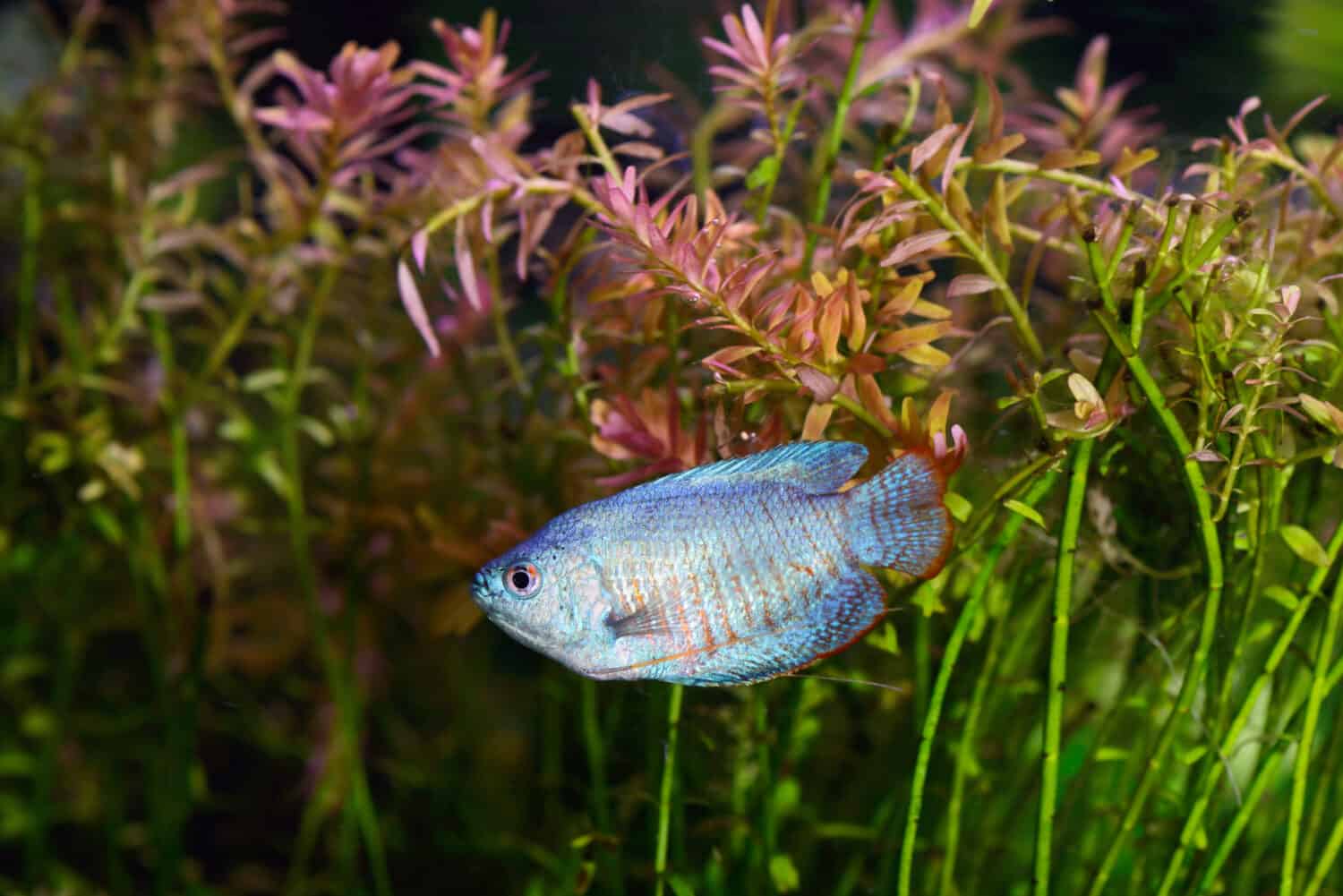
Dwarf gourami do best in a large tank with lots of vegetation, including floating plants.
©Yuriy Chertok/Shutterstock.com
Dwarf gourami come in a variety of stunning colors, such as blues, flame red, and a striking striped blue and dark red rainbow hue. They thrive in the same type of environment as discus do, which makes them a good pick to cohabit in the same tank. These small, peaceful, and shy fish will be happiest in a tank that provides plenty of hiding areas. Dwarf gourami are unique in that they go to the surface of the tank to take in atmospheric oxygen. They are a member of a group of similar air breathers called labyrinth fish.
#5 Harlequin Rasbora (Trigonostigma heteromorpha)
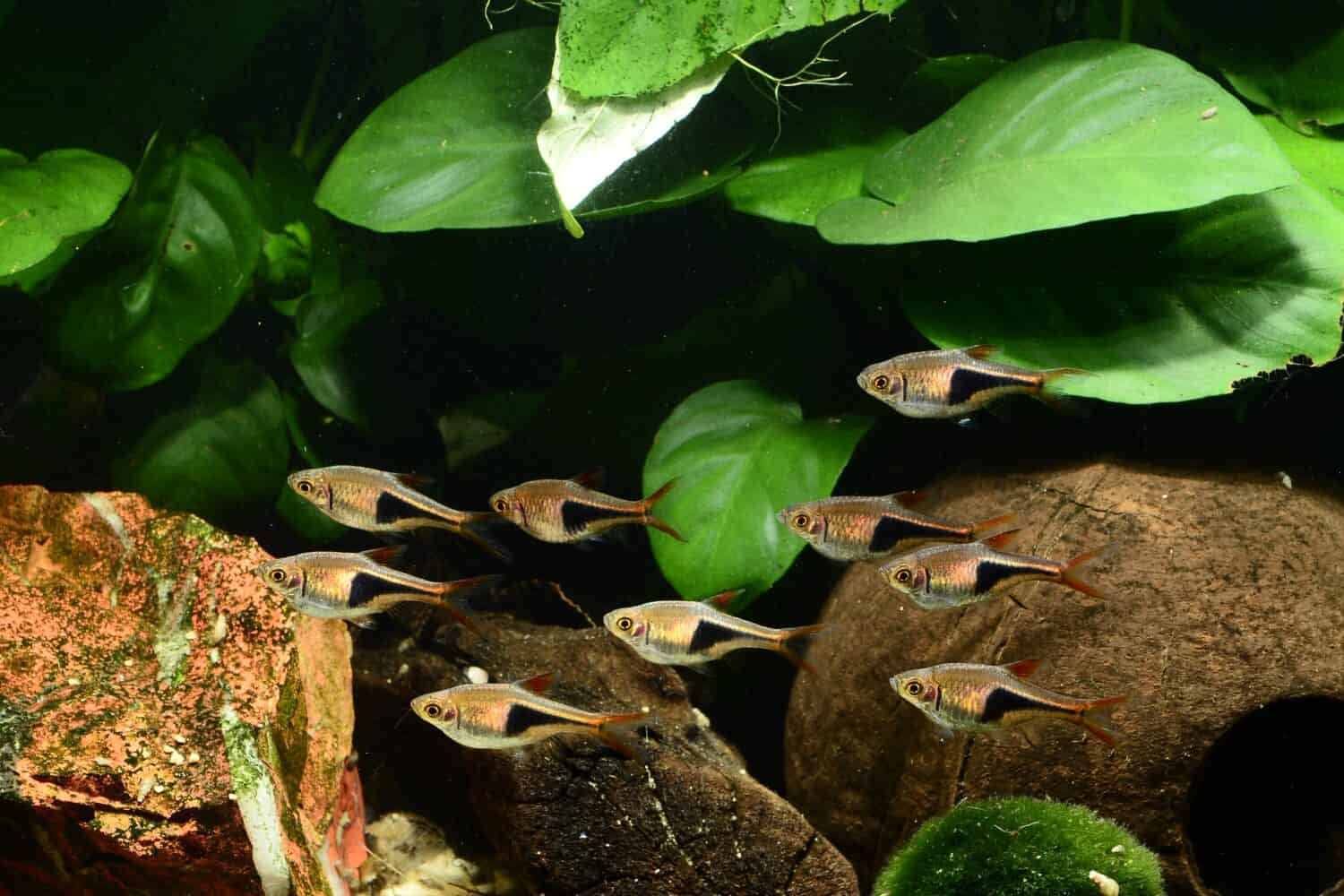
While there are over a dozen types of rasbora fish that team well with discus, the most popular is the harlequin variety.
©JuanCarlosPalauDiaz/Shutterstock.com
The harlequin rasbora has a visually striking black triangle that begins near its dorsal fin. Considered to be the most popular aquarium schooling fish, the harlequins were “discovered” over a century ago. Along with their signature black markings, these rasboras sport a variety of colors from light pink to orange, which can change in different water conditions. The females of the species tend to grow larger than the males.
#6 Rummy Nose Tetra (Hemigrammus rhodostomus)
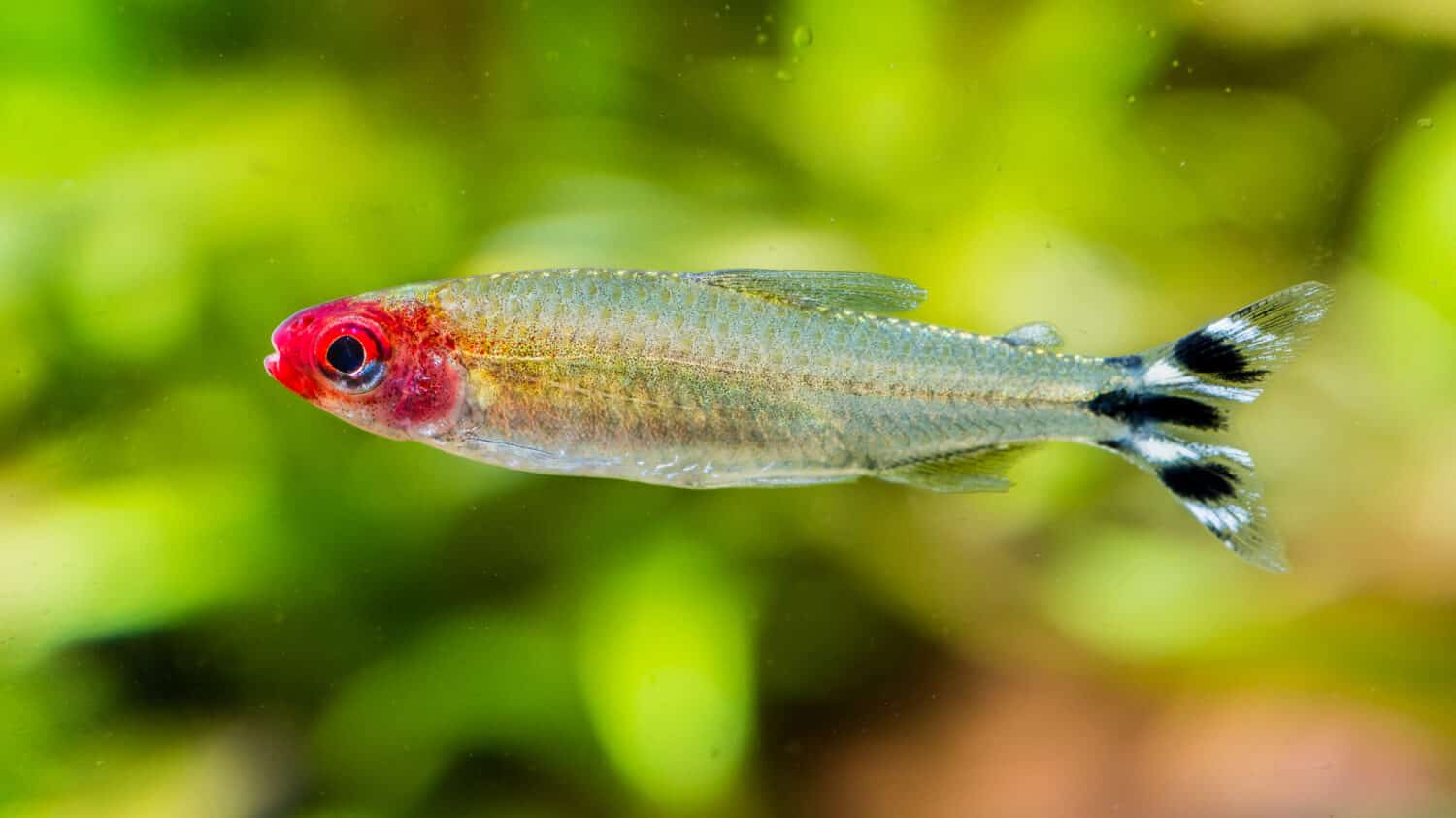
A hardy and peaceful addition to a community aquarium, the small rummy nose tetra is an exceptional tankmate for discus fish.
©Ian Grainger/Shutterstock.com
Sporting a deep red splash of color to its head, the rummy nose tetra has a light greenish iridescent body and either three or five bold black lines on its tail. Being a schooling fish, in its natural habitat, the rummy nose tetra will group in schools of up to several dozen. In a tank, there should be at least six so that they can maintain their instinctive behavior. Called an aquarium “canary,” its head color will become pale if the tank’s water is building up high levels of waste.
#7 Cardinal Tetra (Paracheirodon axelrodi)

As the name implies, cardinal
tetras
add an exciting splash of red to a community tank.
©NattapolStudiO/Shutterstock.com
These small and passive beauties usually congregate in the center of a tank, and they’re especially compatible with the discus. In its native habitat, the cardinal tetra eats fly larvae, insect eggs, and other tiny creatures it scavenges from underwater plants and roots. Cardinal tetras have been known to school in very large groups. When the water acidity is just right in an aquarium, these fish will display their brightest colors.
#8 Neon Tetra (Paracheirodon innesi)
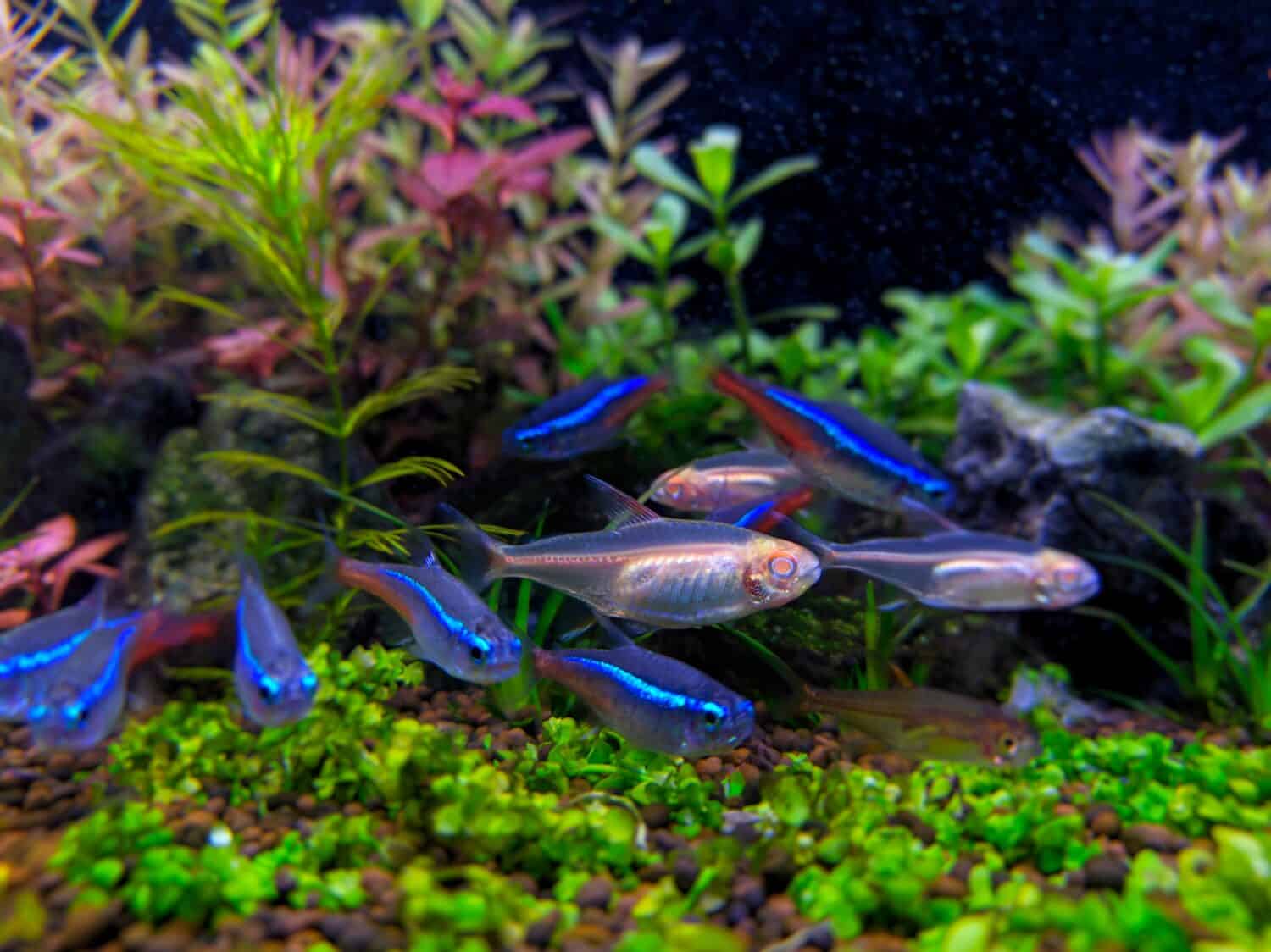
Similar in appearance to a cardinal tetra, the neon tetra is another tranquil aquarium favorite that gets along well with discus fish.
©Afif Fatchurozi/Shutterstock.com
Be sure to keep neon tetras in groups of 10 or more in your tank, as they need company. If too few are kept in a tank, they can become timid, even aggressive. Native to waters in the Amazon River basin, neon tetras live in blackwater areas that don’t see much sunlight. Their flashy markings include a partial red stripe, similar to the cardinal tetra, and an iridescent blue stripe that makes them look “neon” in appearance. When these fish are resting, the blue and red stripes fade to a dark grey. But the color returns when they become active again.
#9 Pencil Fish (Nannostomus)

Another favorite of tank enthusiasts that cohabits very well with discus is the pencil fish.
©Pavaphon Supanantananont/Shutterstock.com
Although there are 17 known species of pencil fish, only two, the golden pencil fish (N. beckfordi) and the blackstripe pencil fish (N. harrisoni), are commercially bred. Pencil fish are happiest in a tank environment that is most similar to their native habitats. That means plenty of dense vegetation. Pencil fish enjoy grouping together with other small species.
#10 Bristlenose Pleco (Ancistrus cirrhosus)
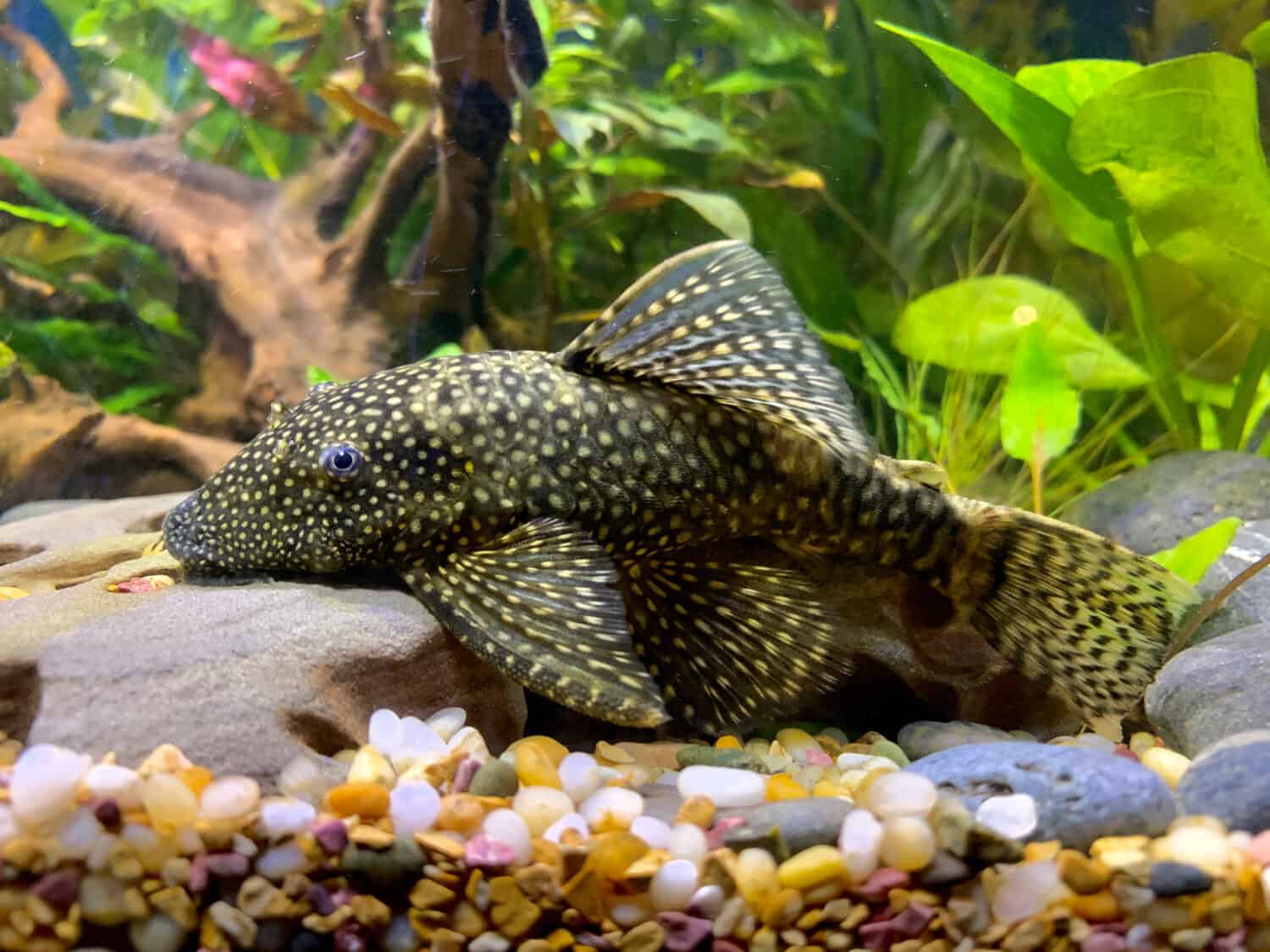
Although there are over a hundred species of plecos, only 10 are suitable to keep in tanks. Of those, the bristlenose variety is the favorite.
©TTONN/Shutterstock.com
Sporting “armored” plates, a sucker-shaped mouth, and a unique spotted pattern, the bristlenose pleco is a favorite tankmate for discus fish. The bristlenose male will grow spectacular tentacles on its face, which it uses when fighting other males. Females may have this “beard” as well, but not to the extent males do. To avoid territorial spats, it’s best to keep just one bristlenose pleco in a tank with discus fish.
#11 Bloodfin Tetra (Aphyocharax anisitsi)

Another schooling fish that goes well with the discus, bloodfin tetras have calm dispositions and are rarely aggressive, even during feeding time.
©Andrzej Zabawski/Shutterstock.com
Another exceptional tetra variety is the bloodfin tetra. They are attractive, easy to care for, and share many of the same good qualities as other tetras. The adult bloodfin tetra grows to be around two inches long, with a glowing, silver body color. Their fins flash a deep red, making them stand out in a community tank. To mimic their native environment, be sure to add plenty of plants. They also need some hiding areas such as caves or even rocks. Bloodfin tetras are active fish that enjoy being in groups of at least five, and even more if your tank is big enough to accommodate a larger number.
#12 Marbled Hatchetfish (Carnegiella strigata)

The exotic-looking marbled hatchetfish tend to enjoy congregating in the top part of the tank where they will stay out of the way of discus fish.
©JuanCarlosPalauDiaz/Shutterstock.com
An unusual-looking freshwater species, the marbled hatchetfish is an accomplished jumper. That makes a covered aquarium a very good idea! They also spook easily, and when they do, they tend to jump. Featuring shimmering, glass-like fins and an interesting body shape, marbled hatchetfish have a peaceful personality and are easy to care for. They should be kept in schools of at least six.
#13 Clown Loach (Chromobotia macracanthus)
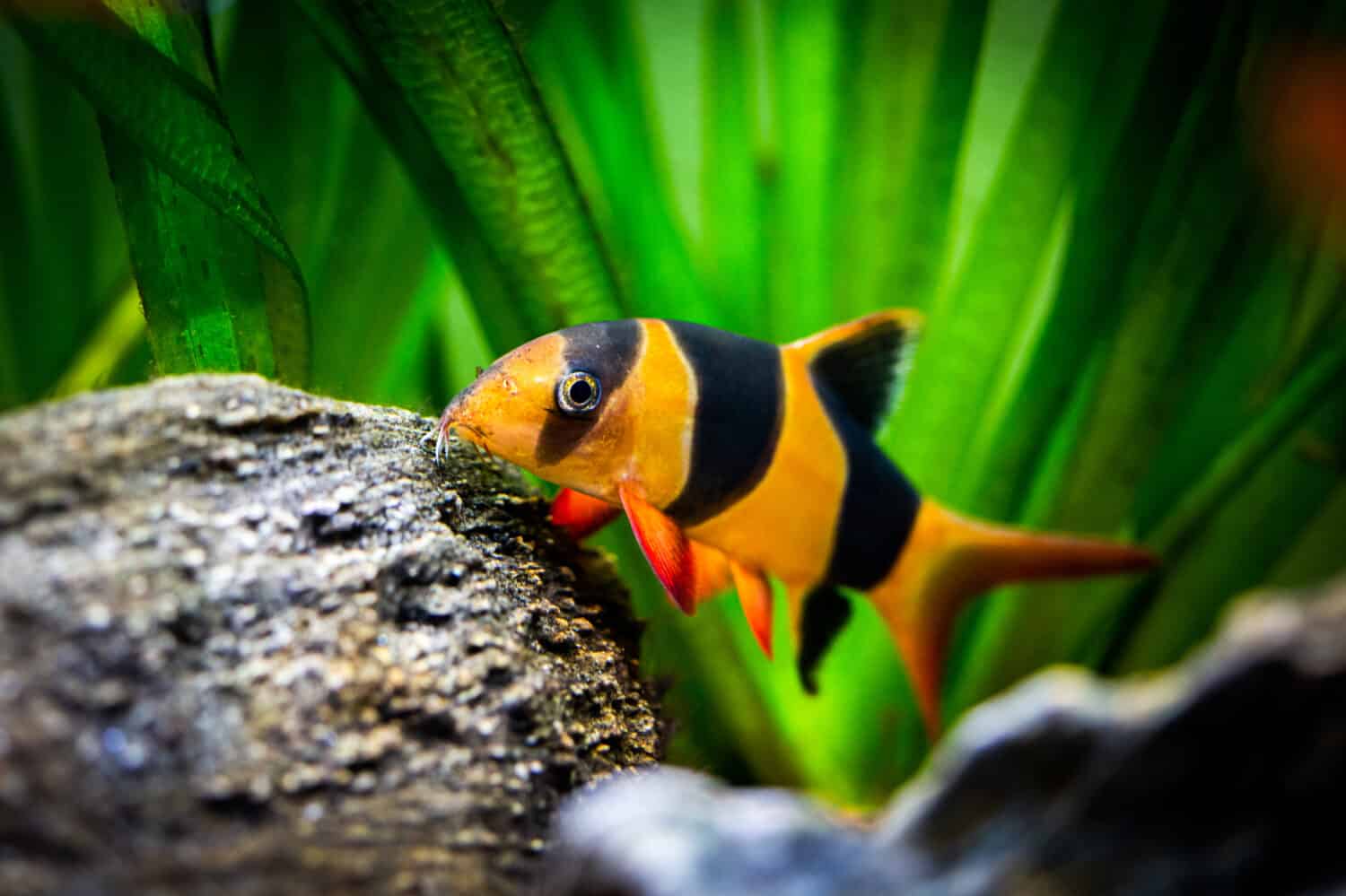
Clown loaches are another good tankmate for discus, despite the fact that they are a quick, darting fish. Including caves in a tank is a good way to settle them down.
©Joan Carles Juarez/Shutterstock.com
These fun fish have been given the nickname “underwater puppies.” Along with their clown-like appearance, they appear to “play,” sometimes chasing each other around the tank. Clown loaches are also known for the unique clicking sounds they make and their habit of grouping together in a corner. If you add these playful fish to your discus tank, be sure to have at least six.
#14 Rainbowfish (Melanotaeniidae)

Another tankmate for discus is the exquisite rainbow fish.
©Aleron Val/Shutterstock.com
With over 50 species of rainbow fish, only ten are considered best for a home aquarium. These include several small varieties, such as the forktail rainbowfish (P. furcatus) and the red neon rainbowfish (P. luminatus). Although rainbow fish can sometimes be aggressive eaters, they seem to get along with the discus, often even hanging out together with them. Rainbowfish enjoy aquarium plants and other types of cover.
#15 German Blue Ram (Mikrogeophagus ramirezi)
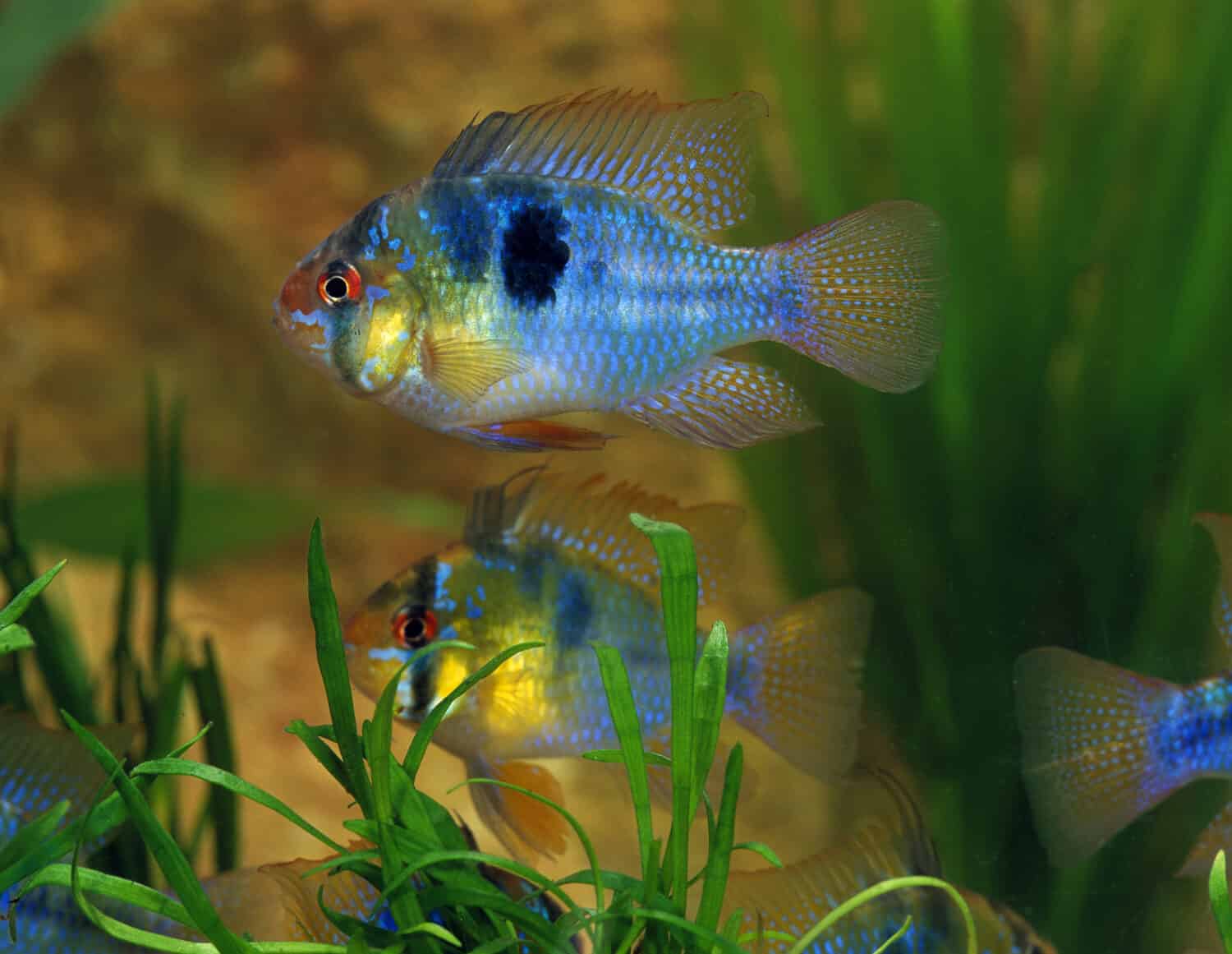
An exquisite small cichlid, the German blue ram can be an excellent addition to a community discus tank, provided the environment includes caves and other types of cover to allow for its territorial tendencies.
©slowmotiongli/Shutterstock.com
These freshwater fish typically grow to be no larger than 3 inches long. Showing an amazing rainbow of colors, the German blue ram is a favorite aquarium fish. Originally from the Orinoco River basin in Venezuela and Colombia, the “German” part of its name comes from a special blue color species that originated in Germany. Blue rams can get bossy with each other, and for that reason, often, one in a community tank is enough!
#16 Freshwater Angelfish (Pterophyllum scalare)
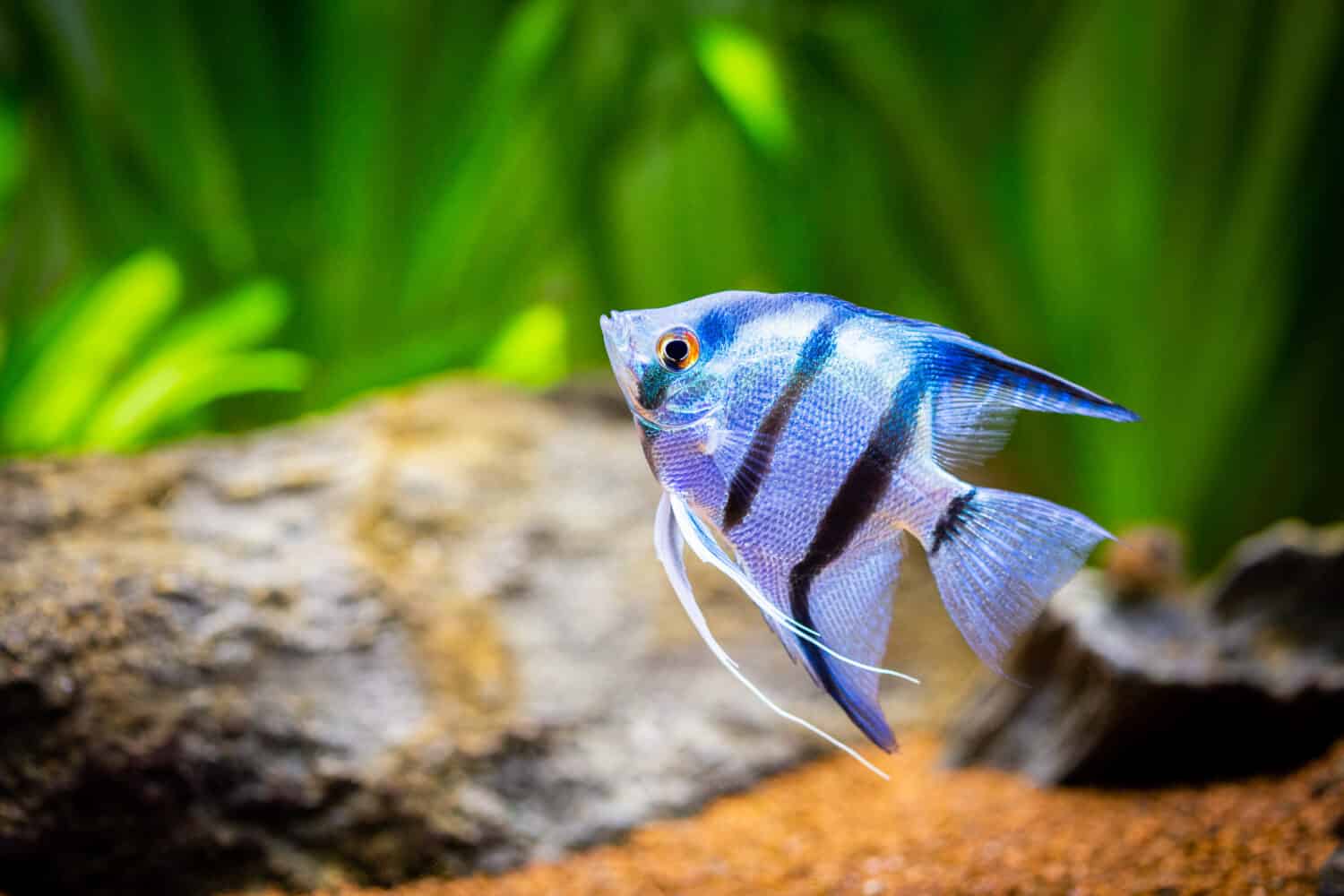
Slow-moving freshwater
angelfish
are often aggressive eaters, potentially overwhelming discus fish during mealtime.
©Joan Carles Juarez/Shutterstock.com
A small cichlid native to South America, the freshwater angelfish sports very long, graceful fins. Although they are considered social fish, they can become aggressive. Simply keeping one angelfish is a simple way to solve that problem, and that doesn’t appear to affect their behavior. Of interest, freshwater angelfish release certain chemicals in the water through their urine and bile that indicate their status in the school.
#17 Peacock Gudgeon (Tateurndina ocellicauda)
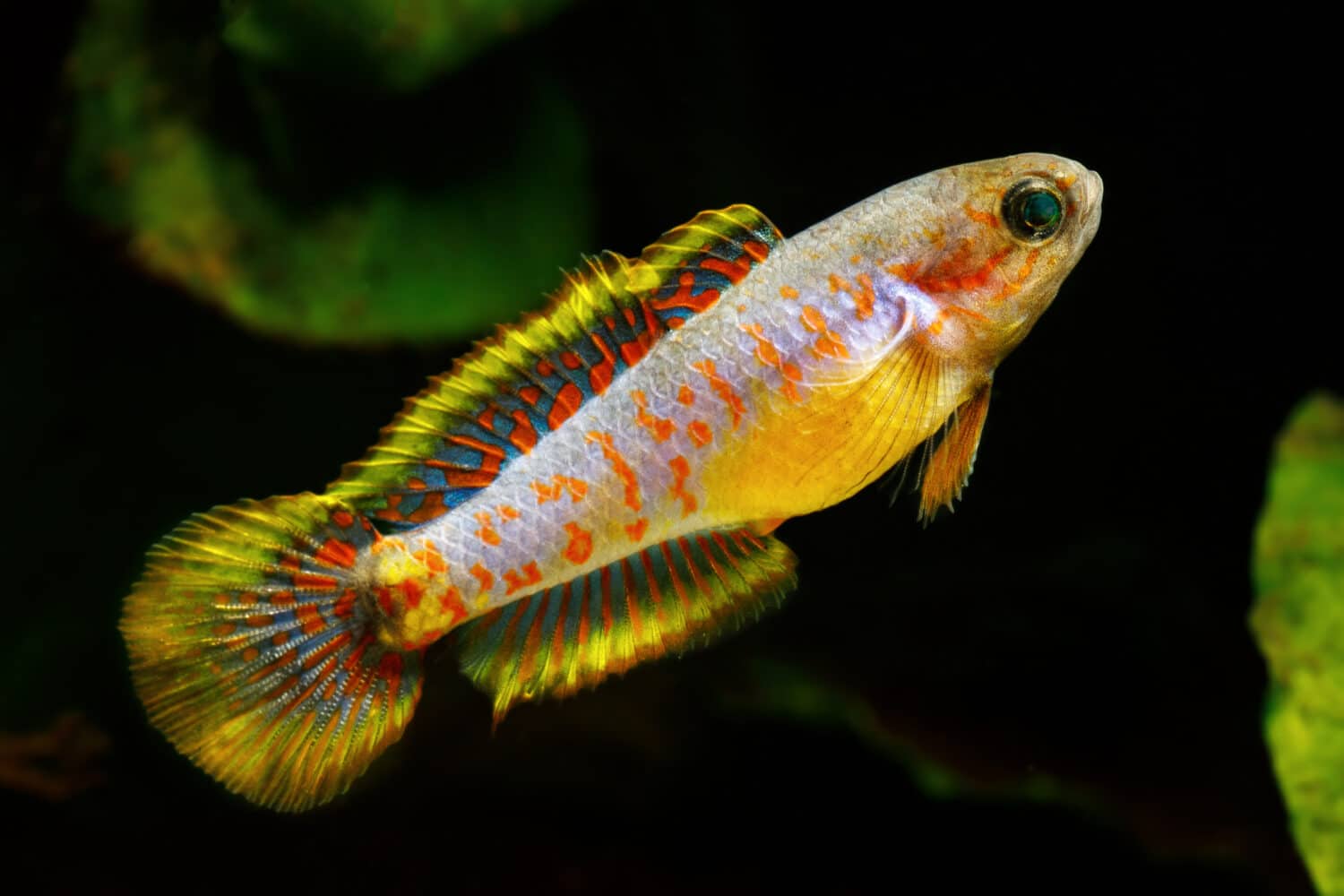
A gorgeous fish native to New Guinea, the small peacock gudgeon is non-aggressive and goes well with other calm species of fish, such as the discus.
©Toxotes Hun-Gabor Horvath/Shutterstock.com
With fabulous peacock-like fins, this shallow-water freshwater fish is a delight to behold. A schooling fish, the peacock gudgeon should be kept in groups of at least six. They enjoy having multiple hiding spots of rocks, driftwood, and vegetation. Males can be up to 3 inches, with females typically growing up to 2 inches long. A peaceful species, they thrive in a community tank.
Summary of 17 Good Tankmates for Discus Fish
| Ranking | Common Name | Scientific Name |
|---|---|---|
| #1 | Siamese algae eater | Crossocheilus oblongus |
| #2 | White cloud minnow | Tanichthys albonubes |
| #3 | Cory catfish | Corydoras |
| #4 | Dwarf gourami | Trichogaster lalius |
| #5 | Harlequin rasbora | Trigonostigma heteromorpha |
| #6 | Rummy nose tetra | Hemigrammus rhodostomus |
| #7 | Cardinal tetra | Paracheirodon axelrodi |
| #8 | Neon tetra | Paracheirodon innesi |
| #9 | Pencil fish | Nannostomus |
| #10 | Bristlenose pleco | Ancistrus cirrhosus |
| #11 | Bloodfin tetra | Aphyocharax anisitsi |
| #12 | Marbled hatchetfish | Carnegiella strigata |
| #13 | Clown loach | Chromobotia macracanthus |
| #14 | Rainbow fish | Melanotaeniidae |
| #15 | German blue ram | Mikrogeophagus ramirezi |
| #16 | Angelfish | Melanotaeniidae |
| #17 | Peacock gudgeon | Tateurndina ocellicauda |
The photo featured at the top of this post is © Nitr/Shutterstock.com
Thank you for reading! Have some feedback for us? Contact the AZ Animals editorial team.




